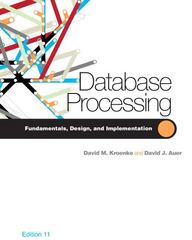Question
Please help me solve this question: A Covering Array (CA) is a combinatorial object, denoted by CA(N; t, k, v), which can be described as
Please help me solve this question:
A Covering Array (CA) is a combinatorial object, denoted by CA(N; t, k, v), which can be described as a matrix with N k elements, such that every N t subarray contains all possible combinations of v symbols at least once. N represents the rows of the matrix, k is the number of parameters, which have v possible values and t represents the strength or the degree of controlled interaction. To illustrate the use of CAs suppose that we have a system with 3 parameters (k) each with 2 possible values (v) labeled as 0 and 1 respectively as shown in Table 1.
Table 1: System with three parameters each with two possible values
| OS | Browser | Database |
| Linux | Firefox | MySQL |
| Windows | Chrome | Oracle |
Assume we want to construct a CA with t=2 from the System described above; thus, a matrix of at least 4 rows is needed to cover vt combinations. A CA that fulfills this this requirement is shown in Table 2:
Table 2: CA (4;2,3,2)
| 1 | 1 | 0 |
| 1 | 0 | 1 |
| 0 | 1 | 1 |
| 0 | 0 | 0 |
In the example shown in Table 2 the total of combinations between pairs of parameters is
3 being these {OS, Browser), {OS, Database), {Browser, Database). Each parameter has 2 settings giving 4
possible combinations for each pair of them.
The definition of a CA implies that every N t sub-array contains all possible combinations of vt symbols at least once, based on this fact, for the tuple {O.S., Web browser) all the combinations {0,0], {0,1), {1,0), {1,1) are covered, the same way for any pair of selected parameters.
Implementation
In this project, you will implement simulated annealing (SA) to try to build a CA s.t. the number of rows
(N) is the lower bound size that tentative can cover the required combinations in each N t sub-array. To simplify the problem, for this implementation, fixed assignments of t=2 and v=2 will be used, that is, only the number of parameters (k) that will be the input varies, being its domain [5,7].
The algorithm will return:
(1) The CA (if it could find it) or display that the solution was not achieved
2 The number of iterations performed in the execution.
(3) What is the stop criterion: solution, frozen, final temperature archived
The implementation will include the following:
* The initial solution will be created randomly, that is, you will initialize the matrix with the corresponding domain of each variable.
* The objective function will count the total of missing combinations in each N t subset, thus being a minimization problem.
* The algorithm will include a geometrical cooling scheme, it starts at an initial temperature Ti =k and which is decremented at each round by a factor alpha=0.99 using the relation Tx= alphaTx-1
* Frozen factor: if after (frozen factor consecutive temperature decrements the best-so-far solution is not improved, the algorithm stops its execution, for this = vt .
* The objective function will count the number of combinations covered in each N t subset, thus being a maximization problem.
* The neighbourhood function randomly selects a column j(1 j k). After that, the function swaps the symbol of each row in Mi,j to create the neighbours, and then evaluates the number of missing combinations in each of them.
Step by Step Solution
There are 3 Steps involved in it
Step: 1

Get Instant Access to Expert-Tailored Solutions
See step-by-step solutions with expert insights and AI powered tools for academic success
Step: 2

Step: 3

Ace Your Homework with AI
Get the answers you need in no time with our AI-driven, step-by-step assistance
Get Started


